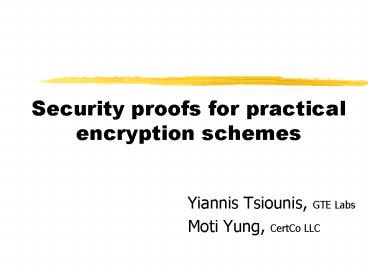Security proofs for practical encryption schemes - PowerPoint PPT Presentation
1 / 17
Title:
Security proofs for practical encryption schemes
Description:
Hide all partial information. Immune against a-priori knowledge 'Security': Semantic security: ... Collision-free Information hiding 'Random oracle' Q. A. i. i ... – PowerPoint PPT presentation
Number of Views:62
Avg rating:3.0/5.0
Title: Security proofs for practical encryption schemes
1
Security proofs for practical encryption schemes
- Yiannis Tsiounis, GTE Labs
- Moti Yung, CertCo LLC
2
Secure encryption
- Semantic Security GM84, Gol89
- Hide all partial information
- Immune against a-priori knowledge
3
Semantic security (cont.)
(Indistinguishability of encryptions)
4
Beyond semantic security
- Chosen ciphertext security NY90
- Lunch-time attack NY90
- Rackoff-Simon attack (adaptive) RS91
- Non-malleability DDN91
- Infeasible to create a related ciphertext
- Message sender cannot be altered by
man-in-the-middle
5
(Random oracles)
- A necessary evil simplification
- Collision-free Information hiding
Random oracle
Q
A
i
i
Requires tamper-proof devices, or exponential
memory
6
The big picture
EG
EGROA
7
Contributions (cont.)
- Semantic security
- Directly from decision Diffie-Hellman
- Retaining homomorphic properties
- Exact analysis of efficiency of the reduction
- Non-malleability
- decision D-H R.O. PS96 oracle-related
assumption
8
Preliminaries
- ElGamal encryption
- P aQ 1, P,Q primes, g Q
- Private key x
- Public key y gx (mod P)
- E(m) gk, yk m (m ? GQ)
- Decision Diffie-Hellman
- P aQ 1, P,Q primes, g Q
- Distinguish lt ga, gb, gabgt from ltga, gb, gc gt
9
Preliminaries (cont.)
- Semantic security indistinguishability of
encryptions - It is infeasible to find 2 messages whose
encryptions can be distinguished (non-negl.
better than random guessing)
10
ElGamal gt decision D-H
- Assume we have ElGamal oracle
- Given a triplet ltga, gb, y gt decide if it is a
D-H triplet (y gab ?) - 1. Preparation stage Find two messages that the
oracle can distinguish - 2. Testing phase test if the oracle can
distinguish between message 1 (or 2) and random
messages
11
Proof (cont.)
- 3. Decision phase generator g, public key gbw (w
random) - Randomize message 1 (or 2)
- Correctly E(m) gu , m (gb)wu
- Based on given triplet ltga, gb, y gt E(m)
(ga)t g v , m ywt (gb)wv - m m (if y gab), random otherwise
- Run oracle on E(m), E(m)
- 1. Distinguish? gt not D-H triplet
- 2. Else correct D-H triplet
12
Decision D-H gt ElGamal
- Given decision D-H oracle, find two messages
whose ElGamal encryptions can be distinguished - For any two m, m (y gx)
- E(m0) ga, m0 ya , E(m1) gb, m1 yb
- Feed ltga, y gv , ya m0 gav /mgt lt ga, gxv ,
g(xv)a m0/mgt (random v) - If it is a correct triplet, then m0m , else m0
m
13
Non-malleability
- Given ciphertext C, cannot construct ciphertext
C such that the plaintexts are related - All we need is a proof of knowledge of the
plaintext - I.e., a proof of knowledge of k in E(m) gk,
yk m - But, it must be a non-malleable ZK proof it must
be bound to the prover
14
The non-malleable extension
- A Schnorr-type ZK proof of knowledge of k, with
the senders identity in the challenge (hash) - A gk, yk m, F gv, C k H(ID, g, A, F) v
- E(m) A, F, C, ID
- Random oracle is used only as a trusted beacon
PS96 - not for information hiding
15
Security proof
- 1. We need to verify that semantic security still
holds (the knowledge proof does not leak
information) - 2. Knowledge of k provided from Schnorr proof
- 3. Sender-bound the addition forms a Schnorr
signature of ID based on k, which is
existentially unforgeable PS96
16
Practical implications Encryption
- ElGamal is as secure as BR94Can97
- Non-malleability can be added at minimal
efficiency costs - In applications a signature is still needed
- Otherwise senders can be impersonated
- Signatures using Schnorr-proofs is a smooth
addition
17
Implications protocols
- First encryption scheme with homomorphic
properties that is semantically secure - Anonymous e-cash escrowing can be performed
based on decision D-H






























